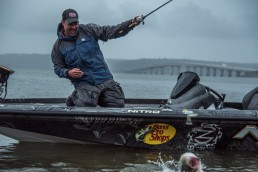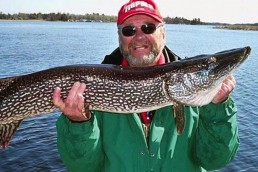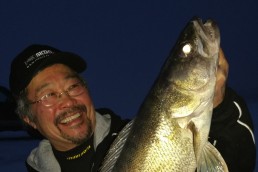Rising Above a Life-changing Fall: Todd Amenrud In his own Words
SHARE THIS POST
As a MidWest Outdoors reader, you know Todd Amenrud for his detailed articles loaded with information on how to hunt big game and birds. From a tender age, he’s been an avid hunter, eventually making a living helping others improve their hunting prospects. He was and is a hunter, to the core. Nothing has changed in that regard.
But his life took an enormous tumble back in 2004. Ironically, while setting up for a celebration of independence, his own became seriously compromised.
“It was the 4th of July in 2004,” begins Amenrud, “and we were having a bunch of people over for a barbecue and fireworks. I had built, by myself, this huge deck and gazebo off the back of my house. I was doing the last thing, staining the shaker shingles on the gazebo. I’d been doing it for a couple days and was finishing up the last little bit, stood up to stretch, can of stain in one hand, paintbrush in the other, and I started sliding off the ladder, and there was nothing I could do.
“I fell 26 feet onto a concrete slab and became a paraplegic instantly.”
The grainy black-and-white x-rays were gruesome and telling, the damage significant and permanent. As just one example, where there had been a vertebrae at L1, there was now just a blank space, the spinal bone having essentially exploded into tiny pieces.
“I can remember looking up the deck stairs at my wife,” says Amenrud, “and she was looking at me like, ‘get up, dummy; finish the job.’ With the biggest voice I could muster, which wasn’t much––because it knocked the wind out of me besides breaking my back––I was trying to say, ‘911, 911.’ Then she knew something was wrong.
“The Anoka County Sheriffs must have been parked at the end of our street, because it seemed like they were there in 30 seconds, and they were so nice to me and helped so much, even shaded my eyes from the sun, because I couldn’t move.”
So on that day, in the bright sunshine, about the time other families were starting their festivities, the rear doors of an ambulance closed and Amenrud’s pain-filled body was driven to Mercy Hospital, where he spent two weeks, waiting for the swelling to go down, and undergoing initial surgeries. In mid July, he was transferred to Sister Kenny Institute at Abbott Northwestern Hospital in Minneapolis, where he stayed two-and-a-half months, beginning to learn about life with his new reality.
This is but one part of his story, told in his own words…
MidWest Outdoors: Losing the use of your lower body changed much, but ultimately not everything, for you. How long did it take for you to come to terms with your new realities?
Todd Amenrud: Oh, my goodness. I would say months, to possibly years. You come to terms gradually with certain aspects of it. My brother was nice enough to build me one of those handicap ramps on the front of my house, so I could get in and out.
In September, when the leaves started to change, it hit me pretty hard. My wife would go to work, and the kids (two daughters) were at daycare, so I was there by myself during the day. I would wheel the wheelchair out into the driveway and just sit––and this is even hard for me to talk about now; very few people know about this. When the leaves were changing I would look at the leaves and ball my ass off. I would cry for hours. It was hard. Nobody knew about that.
MWO: That sounds hard. It probably still is.
Amenrud: It’s not so much anymore, really. I’m guessing I’ve fully come to terms with it. I love life now; it’s a joy.
MWO: It sounds like it took you a while to get to the point where you were ready to test the limits of your new wings.
Amenrud: It did, but I remember when it started. One day it just hit me. It was an epiphany, or realization, but I realized that I could either sit there in my driveway and ball my eyes out and feel sorry for myself, or I could do something about it.
There were so many people who wanted to help me, but I had to do it myself. People helped me; no question, setting up treestands, ground blinds, whatever, they helped me. But I wanted to know I could still do it, myself.
The first hunting season [after the accident], and this is where having managed our property for whitetails for so many years, paid off big time. I was still in a wheelchair, but I could drive myself over toward a good spot I know, and transfer myself from the wheelchair to the ATV. I drove the ATV as close as I could to the spot. I put my bow on my back and physically crawled about 200 yards to where I wanted to hunt.
I backed up into a cedar tree that was right on a creek bank, so I was kind of hidden, and took the snips from my backpack and very quietly cut a little lane here and a little lane there. I was sitting with my butt right on the ground, using a little pad I brought with me.
I could shoot both ways, but it was going to take a lot to get myself turned around. As it turned out, I didn’t need to. Because I had crawled into this area, I must have been so quiet, and they couldn’t see me, I had settled in right among some deer that were bedded down.
All of a sudden, a doe got up from her bed behind me. I didn’t see her, but her fawn then popped up, and another fawn popped up. And about 30 seconds later, a buck must have heard them get up out of their beds, because he came up on the creek bank to observe.
It was perfect cover, because his attention was focused solely on her.
I picked up the bow and drilled him.
MWO: So this is how it all happened, on the first time you tried hunting after the accident?
Amenrud: Absolutely, it was. It was within an hour after I sat down in that cedar tree. This is where managing a property for whitetails works. The Quality Deer Management philosophies produce results.
MWO: Was this hunt in October?
Amenrud: This was actually in November.
MWO: So it took you until then to get a plan together and ready yourself to try it?
Amenrud: Yeah, it took me a long time. I didn’t get past my driveway in September. For a person in a wheelchair, you wouldn’t have believed how hard it was for me to wash my hunting clothes, treating them with Scent Killer, and drying them outside. Doing all those chores took me a couple weeks.
MWO: Tell us some more about that deer; was it a good hit? How far did the deer go before it piled up?
Amenrud: Double-lunged him, watched him fall over 80 yards away.
MWO: Could you still see the deer, after it went down, from where you were sitting?
Are you enjoying this post?
You can be among the first to get the latest info on where to go, what to use and how to use it!
Amenrud: Yes, I made a point to try to get to a position where I could watch him as far as possible. I watched him topple over. Besides that little cedar tree, there wasn’t much cover around. The creek bank is wide open, and that’s why I chose to sit there, because I would have shooting lanes going both ways. Then it’s switchgrass, a few willow trees here and there, but it’s mostly open where I was sitting.
MWO: Can you remember the feelings you were having, and what you were thinking, as you looked out on that deer?
Amenrud: To know that I could still do it, by myself, what a relief. Like having 10,000 pounds lifted off your shoulders. And I immediately began balling my eyes out again.
MWO: But for a different reason this time.
Amenrud: Oh, absolutely; happiness.
MWO: So now you have this deer down, but there is work to do. What time of day was it, and how did you manage the process that all deer hunters go through after a kill?
Amenrud: It was about 4 o’clock in the afternoon, so there was plenty of light left. I called my dad, and he and my mom came out and helped me. I gutted it myself, sitting on the ground, and they helped me load it onto a sled, and I drove it back, behind my ATV, hung it in a tree, and brought it into the processor the following day.
I had plenty of help. I could have done it by myself. It would have taken a bit of effort to torque the deer into the sled, but I could have done it.
MWO: That day marked your return as a hunter. Since then, how many deer and other animals have you taken?
Amenrud: I don’t know for sure. I’d have to go back and count, but I know I’ve taken 37 whitetails that make the Pope & Young record book, and nine other animals that make the Pope & Young book. Some of those I took before the accident, but my biggest trophies have come since.
MWO: It speaks to the truth that not just you, but anyone with physical challenges, should not give up on the idea of being a hunter or angler.
Amenrud: Right, and I think we should all think of ourselves as hunters, not handicapped hunters. Some of us have to make adjustments to how we hunt, but we are all hunters.
When we pick up on the podcast, Amenrud tells the story of what it was like being driven by ambulance on the day of the accident, and the long road back––both physically and emotionally––to that first hunt. He talks about where his life is now, offers great how-to hunting advice, and more, and you’ll find it in the Podcast section at midwestoutdoors.com. On the home page, look for the button that says Podcast, click on it, and you’ll find the interview. Look for it around October 1.
We hope you have time to listen to some of our other episodes as well. We’ll see you there… it’s time well spent.
Amenrud through the years
Born: May 11, 1964, in Anoka, Minnesota.
1971: At 7 years old, shot his first duck, hunting with his father, Randy Amenrud, using an old .410 shotgun.
1972: At 8 years old, shot his first whitetail deer, near his home in Ham Lake. “After that,” he remembers, “I got to go up North to deer camp with the big guys.”
1977: At 13, learned to shoot a bow, beginning with a Bear recurve. “I loved it right away,” he says, “and I got good with that bow.”
1978: At 14, began hunting deer with his recurve bow. “That’s when I really started learning about deer,” he remembers, “and how to get very close without alarming them.”
1978: Began a deep dive into music, learning guitar. “Honestly,” he admits, “I probably started it because I thought it would be a good way to meet girls. But then I started playing, and saw the joy that music can bring to other people, and that made me happy.”
Amenrud’s most successful band was Avalanche, which played, “everything from country to head-banging heavy metal,” he says. It stayed together for 7 years, playing steadily from the Dakotas to Minnesota, Wisconsin, and Iowa.
1980: At age 16, began first job in the outdoor industry, as a salesman at Total Sports in Northtown Mall. Before being graduated from high school, he became one of the co-managers of the hunting/fishing/camping department.
Spring, 1982: Was graduated from Blaine High School, Blaine, Minnesota.
Fall, 1982: Attended McPhail College of the Arts, at the University of Minnesota-Twin Cities campus, studying music theory and guitar. Amenrud had been a professional musician since high school days.
Also worked part-time for what, at the time, was called Roach/Amenrud Fishing Pro-Mo’s, a group started by Randy Amenrud and Gary Roach.
“Starting when I was in high school,” he notes, “I played in a band Tuesday night through Saturday night, almost every week. I was making $400 to $600 a week as a musician, while also working part-time for my dad and Gary. They were on the road so much, and needed somebody to ship out prizes and posters for promotions, and other things like that.”
1988: Changed course professionally, from a primary focus on music, “to doing the other thing I love: hunting. The band still continued to play, but now I got really involved in the outdoor industry. At that time, nobody had the business model that my dad and Gary did, and we took it to the hunting side. Right away, we started signing big companies, like Mossy Oak and Remington, because it was a unique service model. By that time, we had changed the name of the company to Outdoor Promotions & Communications, doing business as Hunting Pro-Mo’s and Fishing Pro-Mo’s.
2002: Assumed control of the company, becoming president. “My dad stayed on as treasurer,” he says with a laugh, “so he constantly reminded me that he was the guy with the money, so it didn’t matter what my title was.”
2004: In a life-changing moment, Amenrud fell 26 feet from a ladder while staining shingles on a gazebo, preparing for 4th of July guests. After three months in various hospitals and rehab centers, he went home to adjust to the new normal.
2004: On a November afternoon, about 4 o’clock, shot first deer after the accident.
MWO
SHARE THIS POST
Did you enjoy this post?
You can be among the first to get the latest info on where to go, what to use and how to use it!
Mark Strand
MidWest Outdoors editorial director Mark Strand is a graduate of University of Minnesota School of Journalism with a minor in Fisheries & Wildlife Science. He has written for nearly every outdoor magazine over the past 41 years, and has written or co-written 14 books. In addition to writing and photography, Strand produces the MidWest Outdoors Podcast, and contributes to MWO digital properties. He is an outdoor generalist who loves hunting and fishing of all types. In 2018 Strand was elected to the Minnesota Fishing Hall of Fame.



